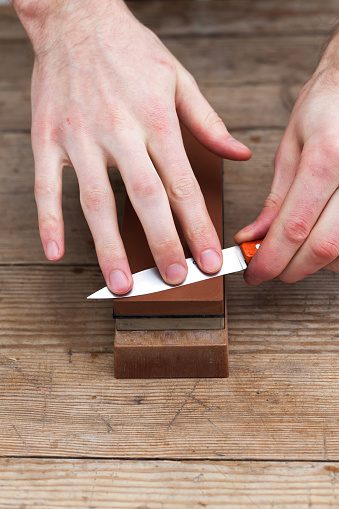Finding the Best Angle for Knife Sharpening: A Professional Guide

As a chef or home cook, you know how important it is to have a sharp knife in the kitchen. A dull knife can be frustrating to work with and can cause accidents. Sharpening your knife is an essential task that needs to be done regularly. However, finding the best angle for knife sharpening can be challenging. In this article, we will discuss the different angles for knife sharpening and help you find the best angle for your knife.
Read More: Can you Put Sharp Knives in the Dishwasher?
Types of Knife Angles
There are different types of angles for sharpening knives. Here are some of the most common angles:
A. 15-degree angle: Ideal for Asian knives.
B. 20-degree angle: Ideal for European and American knives.
C. 22-degree angle: Ideal for hunting and outdoor knives.
D. 25-degree angle: Ideal for heavy-duty knives.
Choosing the Best Angle for Your Knife
There are several factors to consider when choosing the best angle for your knife:
A. The Angle That Comes With Your Knife:
Some knives come with a specific angle already, so it’s essential to check the manufacturer’s recommendations before sharpening your knife.
B. Type of Usage:
The type of knife and its intended use can also determine the best angle for sharpening. For example, a chef’s knife might require a different angle than a hunting knife.
C. Personal Preference:
Personal preference also plays a role in choosing the best angle. Some people prefer a sharper edge, while others prefer a more durable edge.
How to Find the Angle of Your Knife?
To find the angle of your knife, you can use an angle guide or a sharpening stone. Here are some methods to determine the angle of your knife:
Step 1: Angles and Bevels:
The angle of the bevel on your knife can give you an idea of the angle to use for sharpening. You can use a protractor to measure the angle of the bevel.
Step 2: Using an Angle Guide:
An angle guide is a tool that attaches to your knife to help you maintain a consistent angle while sharpening. Place the angle guide on the knife and adjust it to the desired angle.
Step 3: Using a Sharpening Stone:
Place the knife on the stone and adjust the angle until you feel the blade is making contact with the stone at the right angle.
Sharpening Techniques
Once you have determined the best angle for your knife, you can use various techniques to sharpen it. Here are some common sharpening techniques:
A. Using a Honing Rod:
A honing rod is a tool used to maintain the knife’s edge between sharpening sessions. Hold the honing rod at the desired angle and glide the knife down the rod.
B. Using a Sharpening Stone:
A sharpening stone is a tool used to sharpen the knife’s edge. Place the knife on the stone at the desired angle and draw the blade across the stone, making sure to maintain the angle.
C. Using an Electric Sharpener:
An electric sharpener is a convenient tool that can sharpen your knife quickly and efficiently. Place the knife in the sharpener at the desired angle and let the machine do the work for you.
Read More: Best Kitchen Knife Sharpeners of 2023
FAQs
Q. Should I get a 15 or 20 angle knife?
Q. What angle do butchers sharpen their knives?
Q. How do you get a 15-degree angle knife?
Q. What angle do you sharpen steel?
Q. Are all knives 20 degrees?
Q. Can you sharpen a 20-degree knife to 15?
Q. What is the angle of a Japanese knife?
Q. What angle are most chef knives?
Q. What is the angle of a Global knife?
Conclusion
Finding the best angle for knife sharpening is essential to maintain the longevity and effectiveness of your knife. Different knives have different angles that suit their purpose, and personal preference also plays a role. By considering the type of knife, its intended use, and personal preference, you can determine the best angle for sharpening. Use an angle guide or sharpening stone to find the angle of your knife, then use a honing rod, sharpening stone, or electric sharpener to sharpen the blade. Regularly sharpening your knife will help avoid dullness, accidents, and frustration. With these tips, you can keep your knives sharp and ready for any kitchen task.




